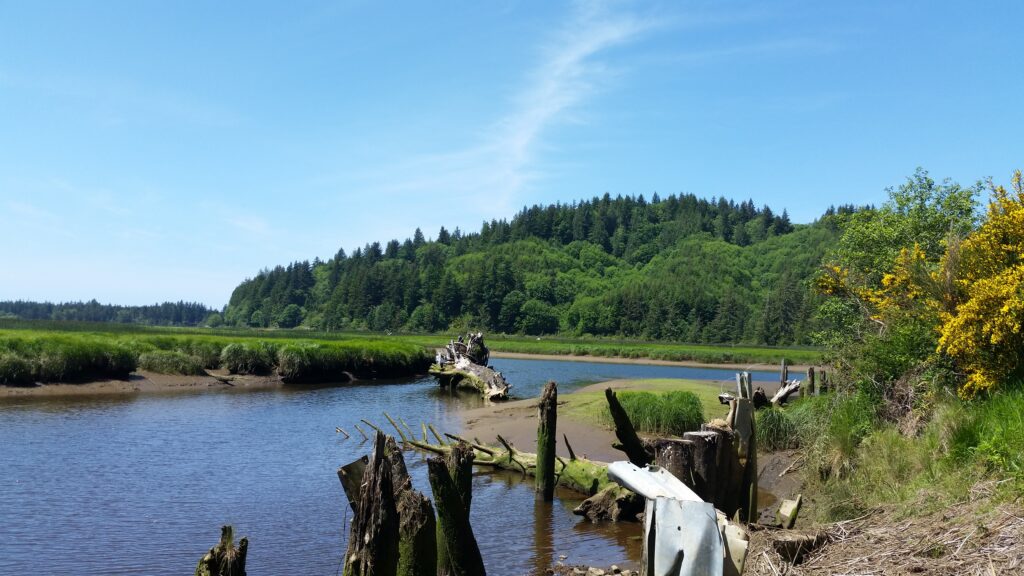Efforts to protect estuarine wetlands in the lower Siuslaw River watershed got a big boost this month with the addition of 245 acres of conservation land. Protected through a partnership between The Nature Conservancy in Oregon and McKenzie River Trust, with support from the Oregon Watershed Enhancement Board (OWEB), U.S. Fish and Wildlife Service, and private donors, the area on the lower North Fork of the Siuslaw River provided the “missing piece of the puzzle” in a larger effort to promote a more resilient watershed through land protection and restoration activities.

The 245-acre parcel builds on more than 1,200 acres of land already under some form of permanent protection in the area. “The addition of the North Fork Bend property into conservation makes possible several opportunities to promote coho recovery, climate resiliency, and cultural connections in the lower Siuslaw basin” shares McKenzie River Trust’s Conservation Director, Eli Tome. “Working in collaboration with landowners who are seeing the value of their farmland decreasing due to changes in the watershed, we are bringing financial resources to keep these working lands working.
The difference is, that instead of supporting cattle, they’ll now support salmon, a healthy estuary, and a more resilient landscape.” The area provides an important habitat for coho salmon to adjust between the ocean and freshwater stages of their lives. “Investments in functioning wetlands are investments in our local economy. This project will have wide-ranging benefits for our local community, infrastructure, and resilience, especially for the fisheries which have been hit hard by low returns of salmon over the last several years.”

The area has been supporting sheep and cattle production since the 1930s. Longtime resident rancher Nathan Large, who sold the property for conservation, has worked with McKenzie River Trust and its partners since 2016. “I’ve been running cattle here seasonally for 20 years.” Shared Nathan. “These low-lying tidally influenced areas just don’t produce enough agriculturally to pay off. When a dike breaks or a tidegate fails, it becomes cost prohibitive to keep the land in production.”
Protecting the property was made possible through a collaborative effort. The Nature Conservancy in Oregon worked with public and private funders to secure the property for conservation. In June, they donated it to McKenzie River Trust, a local land trust that has been working on Oregon’s central coast since 2004.


“When approached by the Large family about this property, we immediately knew it was one of a kind,” said Jason Nuckols, Project Manager for The Nature Conservancy in Oregon. “Without the passionate donors who supported this project, we couldn’t have leveraged the necessary public funds, and this project would never have been completed. This work adds to a long list of projects The Nature Conservancy has successfully partnered with McKenzie River Trust on for over 20 years.”
Looking to the future of the property, partners are preparing to implement enhancement projects to aid the river in its recovery. In 2018, partners contracted Wolf Water Resources to conduct a restoration feasibility analysis for the area to provide a roadmap for addressing some of the watershed’s most immediate threats. In 2023, neighbors donated 85 acres of adjacent tidal wetlands which will be included in restoration planning for the area. “We’re working to combine efforts across multiple properties to reduce costs and expand the benefits of functioning wetlands in the area.” Shared Nathan LeClear, Restoration Project Manager for McKenzie River Trust. “The North Fork of the Siuslaw is an important refuge for native Coho salmon, lamprey, birds, and large mammals, including Roosevelt elk and black bears. Restoring tidal influence to the wetlands here will improve conditions for fish, wildlife, and the people of the Siuslaw River basin.”

McKenzie River Trust received funding from the National Fish and Wildlife Foundation and the Oregon Watershed Enhancement Board to support restoration design and engineering for the area and adjacent lands. Working closely with The Nature Conservancy in Oregon, Confederated Tribes of Coos, Lower Umpqua and Siusalw Indians, and the Siuslaw Watershed Council, projects are currently in the design phase with the goal of restoring more than 550 acres of land within the estuary by 2030.
Having fought the tides for decades, Nathan Large is pleased to see the land returning to the river. “I’m not in favor of converting good agricultural land, but I don’t see this as a conversion. it’s just putting it back to the way it was.” Large, who lives on an adjacent property, remarks at the abundance of birds and other wildlife who use the property. “That’s what it’s suited for, wildlife rather than ag. I look forward to seeing the positive change as the area is restored.”


